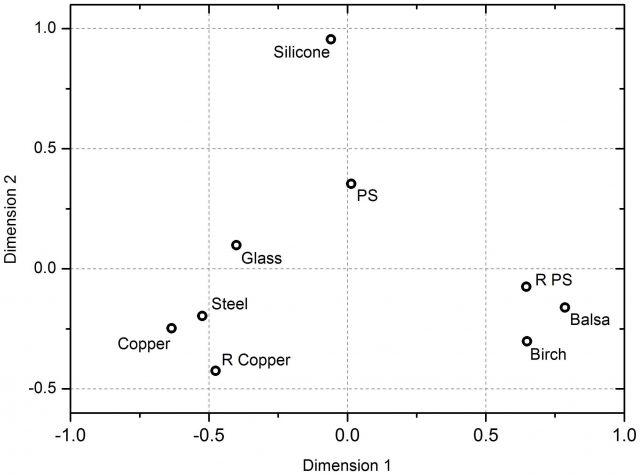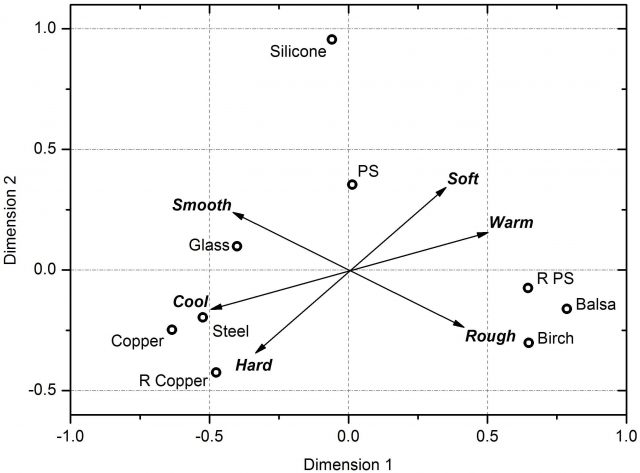Sensoaesthetic materials: food for thought
Nowadays, our role as consumers controls most of our spare time. We find delight in looking for that object that symbolizes our values, our aesthetic categories, or at least the kind of thing we are comfortable with. We might well say that product design has become part of our daily lives as consumers and, strangely enough, we all have developed a specific taste revealed in every object that surrounds us.
Mobile phones, computers, cars, clothes, furniture, buildings, food… every product is subjected to a design process in which functionality and aesthetic appeal must be integrated in the same concept. This link between technical and aesthetic properties is strongly influenced by the materials selected during the design process of a product. If the American architect Louis Sullivan claimed that “form follows function”, we can also say, as it is pointed out by Professor Mike Ashby in his work Materials and Design 1, that “form follows material”.
However, in the last century the development of new materials has rarely been driven by sensual or aesthetic values, even when their final use plays an important role in the arts community (product designers, architects, fashion, visual and performing arts,…) or in leisure activities (sports, travelling,…). This argument is claimed2 by Mark Miodownik, head of the Materials Research Group at King’s College London, who has coined the concept of Sensoaesthetic materials, referring to the application of quantitative and qualitative analysis to determine sensual, aesthetic and psychological properties of materials.

The way in which new materials are developed usually starts by identifying the material’s structure at different scales and then finding the properties derived from this structure. Once the structure-property relationships of a certain material are completely understood, we can modify, improve or tune these properties by changing the material’s structure. But when it comes to the sensoaesthetic properties of a given material, this process becomes much more tricky, as they are mainly governed by the senses and certain psychological aspects which are not directly measurable. Sensoaesthetic properties are subjective, and this poses a big problem to follow a scientific methodology.
Nevertheless, some material scientists are making good progress in the quantification of sensoaesthetic attributes by trying to correlate the perceived properties of materials with certain measurable physical properties. In a recent example3, Miodownik focuses on the perception of a range of different materials (birch and balsa wood, glass, stainless steel, copper, silicone and polystyrene) through oral sensation. It seems that certain somatosensory sensations, that is, those that contribute with chemical, thermal and mechanical stimuli, dominate over the basic taste factors (bitterness, sweetness, saltiness and sourness) in the mouth. Warmth, hardness and roughness have been found to be the most relevant somatosensory factors contributing to sensory perception and thus these are the main properties to link to measured physical property data.
Regarding the perceptual roughness of a certain material in the mouth, two physical properties are involved: surface roughness, referring to height differences along the material surface, and also a second mechanism involving a vibrational component, finely tuned to detect small changes in the surface’s structure. In the case of perceptual warmth, it is not directly related to the material temperature but to the rate of heat transfer from the material to the mouth, and the physical properties involved are thermal conductivity, density and heat capacity, all of them encompassed in the material’s thermal effusivity. As for the perceptual hardness, it has been found that the physical properties describing this factor are the elastic modulus for stronger and stiffer materials and stiffness for softer and more elastic materials.
In order to obtain quantitative data regarding these perceptual factors, the study of Miodownik uses thirty-eight participants who taste each material and then they are asked for rating the materials according to the somatosensory and taste factors (for example, how close they feel glass and polystyrene from 0 to 20, or how salty they feel birch wood or copper from 0 to 7). In a second experiment, this time looking for qualitative data, the participants were asked to freely describe the materials taste with their own words, in an attempt to find out if common perceptual terms are sufficient when describing oral sensations.

Quantitative data are treated using multidimensional scaling (MDS), a statistical technique widely used to obtain visual maps showing the similarities or dissimilarities of a set of objects in terms of the proximity between them. According to the data obtained from the participants of the study, showed in figure 2 as a MDS map, metals are place together, as well as woods, being the most distant materials silicone and polystyrene. In figure 3, the visual map shows that woods and rough polystyrene (R PS) are considered as “warm and rough”, while metals are “cool and hard”, glass is “cool and smooth” and polystyrene was described as being “soft and smooth”. Silicone, although quite distant, would be in the “smooth and soft” area.
The truth is that in the second experiment, the one in which the participants are not constricted in their descriptions to the somatosensory (warmth, hardness and roughness) and taste (bitterness, sweetness, saltiness and sourness) factors, a new vocabulary emerges, enriching these categories with new adjectives such as “earthy, bloody, soapy, fibrous, weird, bubblegum, popcorn…” This result shows the importance of a first qualitative approach when dealing with subjective property data in order to establish an appropriate group of categories for later quantitative analysis.
The study finally finds a strong correlation between somatosensory factors and the physical properties associated with them. While in previous studies devoted to touch perception roughness was found the most relevant factor, it seems that the weakest correlation in oral perception is that of perceived roughness and the corresponding measured surface roughness, probably due to the saliva lowering the friction between the material and the mouth, being the closest correlation that of perceived warmth and thermal effusivity.

At the end of the day, the main purpose of this kind of studies is to accumulate both qualitative and quantitative data which can be used to predict sensory perception and thus help not only product designers, but also the whole materials art community. Miodownik and many other material scientists are working to promote this collaboration between arts and science, which can only enrich both fields of knowledge. Just if we look back through history, we can see that materials are not only influenced by scientific progress, but also by culture, context, personality, emotional delight and many other subjective factors.
References
- Ashby, M. & Johnson, K. (2013) Materials and Design: the art and science of material selection in product design. Oxford: Butterworth-Heinemann Ed. ↩
- Miodownik M. A., Toward designing new sensoaesthetic materials, Pure and Applied Chemistry 79 (10), p. 1635, 2007. doi:10.1351/pac200779101635 ↩
- Howes P.D., Zoe Laughlin, Harry J. Witchel & Mark Miodownik (2014). The Perception of Materials through Oral Sensation, PLoS ONE, 9 (8) e105035. DOI: http://dx.doi.org/10.1371/journal.pone.0105035 ↩
2 comments
[…] Egun, material berrien garapenean pisu berezia dute, irizpide teknikoez gain, irizpide estetikoek eta sentsorialek. Hau ez da harritzekoa, kontuan hartzen badugu diseinuak zer nolako garrantzia duen gure munduan. Silvia Románek azaltzen digu haren artikuluan: Sensoaesthetic materials: food for thought […]
[…] En un mundo cada vez más dominado por el diseño no es de extrañar que la selección y evolución de nuevos materiales se produzca en función de criterios estéticos y sensoriales, además de los puramente técnicos. Silvia Román en […]